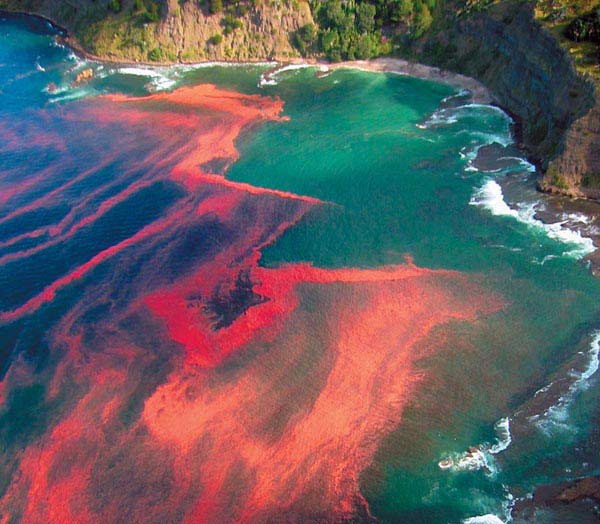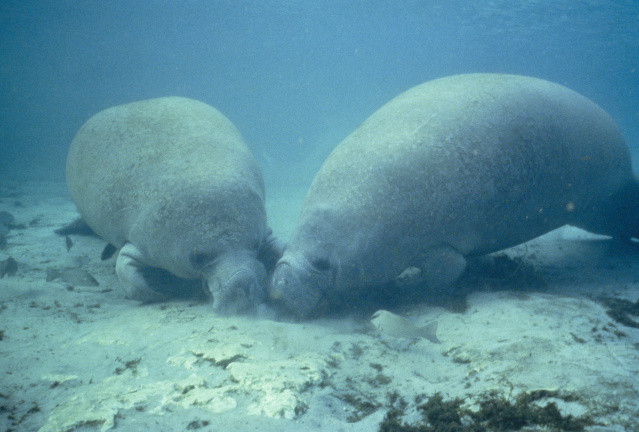Interactions
The Trichechus manatus is considered to be endangered by the
U.S Department of Fish and Wildlife services. Because the T.
manatus has virtually no natural predators we can deduce
that their endangered status is due to human interaction and/or
destruction of their natural habitat.
In 2006, 151 manatees were reported to have been killed of the
southwestern coast of Florida due to the effects from of the Red
Tides (Flewelling et al., 2005). Red
Tides (shown below) are algae blooms caused by a high
concentration or micro-organisms called dinoflagellates. The
presence of one dinoflagellate, named Karenia brevis,
produces a neurotoxin called brevetoxin
(Lin et al., 1981). Red Tides are most common in coastal
regions and are estimated to kill hundreds of manatees each year (Flewellin et al.,
2005).

The most prevalent effect on T. manatus mortality comes from us
humans. Nearly 50% of documented T. manatus deaths are
attributed to human related incidents (Nowacek
et al., 2004). The habitat of
T. manatus is in the coastal regions of bodies of
water which also happen to be the most popular areas for boats.
Collisions with boats are estimated to account for 30% of adult
manatees fatalities (Sorice et al.,
2003). Nearly all manatees that are observed in the wild have scarring
from incidents with boats. An example of scarring that occurs is
shown in the picture of the manatee below. A study performed by
the Florida Research Institution explains that while manatees
recognize the danger of incoming vessels, they are often not
fast enough to get to deeper water quickly enough to prevent
damage (Sorice et al., 2003).

T. manatus have a diet
nearly entirely comprised of sea vegetation,
(Mignucii-Giannoni et al., 2006).
This vegetation grows in the shallow coastal regions of water
because it requires adequate sunlight to survive. It is
estimated that only 80% of this sea vegetation present in 1900
was still present in 1980 (Sorice et
al., 2003). In addition to the loss of sea grass, the
quality of the sea grass present has drastically decreased. The
run-off of nitrogenous wastes and the water pollution by boats
has caused the level of nutrients in the sea vegetation to be
severely lowered (Mignucii-Giannoni et
al., 2006). Florida has recently begun taking measures to
control nitrogen loading into watershed, and this has helped
increase the levels of water vegetation, and increase the
quality. (Sorice et al., 2003). It
will become increasingly important for the governments of coastal
areas
with year round warm water to take similar conservation efforts.
Without these regulations in winter habitats, migrating manatees
will have to swim further and concentrate into smaller areas
just to forage in sub-par environments
(Mignucii-Giannoni et al., 2006).
If we as humans don't stop taking our bodies of water for
granted, and continue this current trend of careless pollution,
we might lose a multitude of water dwelling creatures like the
T. manatus. If you would like to learn more about the
steps that Florida has been taking to keep their water follow
this link to the
Florida Department of Environmental Protection. If you would like to learn more about the
endangered status of Trichechus manatus follow this
link to the
U.S Department of Fish and Wildlife Services.
